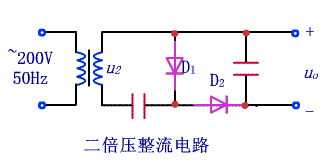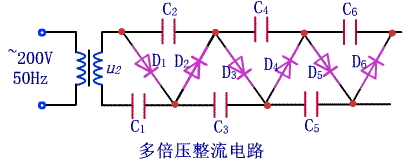Electromagnetic flowmeter and the necessity of electrode selection - Database & Sql Blog Articles
Double voltage rectification is a technique used to increase the output voltage of a power supply. It relies on the energy storage properties of capacitors and the directional behavior of diodes. By using multiple capacitors and diodes in a specific configuration, it's possible to achieve an output voltage that is several times higher than the secondary voltage of the transformer. This type of circuit is known as a voltage doubler.
The working principle of a voltage doubler is based on alternating current (AC) cycles. During one half-cycle of the AC input, one diode conducts while the other is off, allowing a capacitor to charge. On the next half-cycle, the roles are reversed, and the second capacitor charges. The combined effect of these two charging phases results in an output voltage that is approximately twice the peak voltage of the secondary winding of the transformer.

★ When u2 is positive, D1 turns on and C1 charges up to the peak voltage of u2. At this point, D2 is reverse-biased and does not conduct.
★ When u2 is negative, D2 turns on and C2 charges up to the same peak voltage. Meanwhile, D1 is off, and C1 remains charged.
As a result, the voltage across C2 becomes twice the peak voltage of the secondary side of the transformer. This principle can be extended further to create multi-voltage rectifier circuits, where additional stages of capacitors and diodes are added to multiply the output voltage even more.
Multi-voltage rectifier circuits work on the same basic concept. For example, by adding more stages, you can achieve 3x, 4x, or even higher voltage outputs. Each stage contributes to the overall voltage, and by tapping into different points in the circuit, you can obtain various levels of voltage depending on your application needs.

In the diagram above, the multi-voltage rectifier circuit demonstrates how each capacitor stores energy during different parts of the AC cycle. The output voltage is derived from different combinations of these capacitors. For instance, the voltage at C1 is one level, while the voltage at C2 adds to it, and so on. This allows for multiple voltage outputs, making the circuit highly versatile for different power supply requirements.
Whether you're designing a high-voltage power supply for industrial applications or a simple DC power source for electronic devices, understanding the principles of voltage doubling and multi-voltage rectification is essential. These techniques help engineers optimize performance, reduce component count, and improve efficiency in various electrical systems.
99% Ceramic Accessories,99 Porcelain Square Pieces,Ceramic Square Pieces,99 Ceramic Square Pieces
Yixing Guanming Special Ceramic Technology Co., Ltd , https://www.guanmingceramic.com